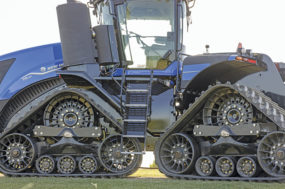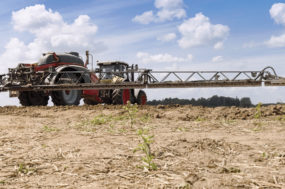As you read this article, I’m sure many of you are watching the weather report and preparing to cut or have just cut the first hay crop of the year.
Hay growers face a multitude of risks throughout the growing season, and while everyone is focused on minimizing risks in the field in order to produce a quality crop, it is important not to overlook protecting the final product until it is delivered.
The most dangerous peril faced once hay is in the stack is fire. In a matter of minutes, a hay fire can eliminate an entire year’s revenue stream.
This risk can be – and usually is – transferred to an insurance carrier. This article will discuss the importance of knowing your policy, coverage options and, most importantly, ways to reduce the risk of hay fire.
With the strong market we have experienced over the last couple of years, the exposure for many growers has increased dramatically.
High hay prices ultimately lead to larger losses in the event of a hay fire. The economic impact of these losses can be devastating, and for this reason, it is important to know your policy.
Large losses over the last few years have caused many carriers to re-evaluate their offers of coverage. As an industry, we have seen rate revisions, narrowing policy language and increased emphasis on risk management.
The most effective way to make sure you are protected is to discuss your policy with your insurance broker.
Policy language will differ from carrier to carrier, so it is important to communicate the specific needs of your operation so your broker can seek out the most effective coverage.
Important considerations include stack limits (know if your policy uses a dollar limit or a tonnage limit per stack), stack yard limits, separation requirements, whether or not you have coverage away from the insured location, deductibles and co-insurance.
These items should be discussed before the first bale is placed in the stack to make sure you are in compliance with your policy. Learning the “rules” of your policy after a claim has occurred can prove to be problematic.
As mentioned earlier, policy language will differ between insurance companies. Discuss these differences with your broker.
Many companies offer several options for reporting your inventories. These options allow you to pay for your true exposure.
For example, if your inventory is substantially higher between June and September, it is possible to structure your policy to provide adequate coverage during these months without paying for the higher limits throughout the year.
Another thing to consider when reviewing your policy is your deductible level. Increasing your deductible may result in substantial premium savings.
While most growers insure hay within their farm package, another option to consider is securing coverage through a crop insurance carrier.
Several crop insurance companies offer a hay fire policy. These policies may be advantageous as they can be written for a variety of time frames.
The flexibility of purchasing a 30-day, 60-day or 90-day policy is often attractive and may meet your specific needs.
Once again, each company will have different policy language, so know exactly what you are purchasing.
Securing the appropriate coverage for your operation will protect you in the event of a hay fire. However, eliminating hay fires completely will ultimately lead to greater profitability.
Best practices include avoiding stacking hay or straw next to buildings, power lines, electric fences and trees.
Avoid parking equipment and vehicles next to haystacks, and keep fire extinguishers onboard as equipment fires can spread quickly to haystacks.
Stacks should be at least 100 feet apart. Try to keep ample separation from roadways and use multiple stack yards to spread your risk as much as possible.
Communicating these risk management ideas to all employees and making sure they understand their importance can substantially reduce your overall risk.
With the season fast approaching, communication is key. It is imperative to discuss your specific coverage needs with your broker.
Make sure you have secured adequate coverage limits, understand spacing requirements and have all locations covered before your crop hits the stack yard.
Remember that there are several options for managing fluctuating inventories and explore those options to ensure you are purchasing the appropriate coverage at a competitive price.
If you are seeking short-term coverage, look to a crop insurance carrier, as they may have a program that works for you.
And remember, emphasizing risk management throughout your organization can greatly reduce the risk of hay fires, leading to increased profitability and lower insurance costs. FG
PHOTO
Photo courtesy of Glenn Shewmaker.

Austin Manning
Insurance Broker
HUB International Mountain States Limited











